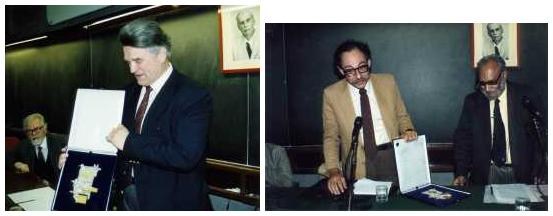Ludwig D. Faddeev, Steklov Mathematical Institute, St. Petersburg, Russian Federation
for researches in the area of quantum field theory and mathematical physics. His name is well known in theoretical physics in connection with the Three Body System (Faddeev's equation). He made decisive contributions to the quantization of the Yang-Mills and gravitational field. The Faddeev-Popov covariant prescription of quantization of non-Abelian gauge theories discovered in 1966-67 has many essential applications including quantum effects in the Glashow-Salam-Weinberg model of electroweak interactions and in quantum chromodynamics. Faddeev is a disciple of Dirac's ideas in theoretical physics. His studies are related with the evolution of the Dirac Hamiltonian interpretation in the inverse scattering method (1971) and with exact integrable systems, as well as with quantum theory of solitons (1975). He also clarified the group-theoretical origin of anomalies in the context of cocycles (1984). His works stimulated the wide-spread application of solitons in relativistic quantum field theory. Faddeev's contributions to the quantum inverse scattering method and 4-matrix theory initiated the development of this direction which is now known as the Quantum Group Approach. His scientific work significantly contributed to the broad extent of geometrical and algebraic ideas in modern theoretical and mathematical physics.
Sidney R. Coleman (1937-2007)
Harvard University, Cambridge, USA
for his contributions to quantum field theory and particle physics. His work on quantum field theories has greatly clarified their structure. This includes the classification of all possible bosonic symmetries of S-matrix (with J. Mandula) and the study of some fundamental properties of two-dimensional quantum field theories including, in particular, the absence of symmetry breaking and aspects of boson-fermion equivalence. His study (with E. Weinberg) of the quantum effective action and the phenomenon of dimensional transmutation has had an important influence on the development of the subject. This includes his work on the fate of false vacuum, on the discovery of Q-balls, and more recently, on the potentially far-reaching physical consequences of wormholes. These contributions are paralleled by the equally important one of teaching the younger generation of particle physicists the modern concepts in quantum field theories through very lucid lectures and papers.

















